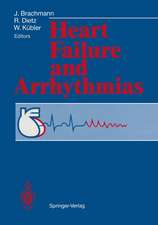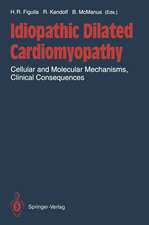Stroke Prevention in Clinical Practice
Autor Daryll M. Bakeren Limba Engleză Paperback – 10 dec 2007
Stroke Prevention in Clinical Practice fills the need for a short clear text to explain how to accurately diagnosis a TIA, determine what investigations are indicated and how and when to intervene to reduce the risk of stroke.
Short chapters written in point form with clear diagrams and figures, each chapter written by an expert in the field.
Preț: 357.97 lei
Preț vechi: 376.80 lei
-5% Nou
Puncte Express: 537
Preț estimativ în valută:
68.51€ • 74.39$ • 57.54£
68.51€ • 74.39$ • 57.54£
Carte tipărită la comandă
Livrare economică 22 aprilie-06 mai
Preluare comenzi: 021 569.72.76
Specificații
ISBN-13: 9781852339647
ISBN-10: 1852339640
Pagini: 140
Ilustrații: VIII, 132 p. 30 illus.
Dimensiuni: 127 x 203 x 7 mm
Greutate: 0.15 kg
Ediția:2008
Editura: SPRINGER LONDON
Colecția Springer
Locul publicării:London, United Kingdom
ISBN-10: 1852339640
Pagini: 140
Ilustrații: VIII, 132 p. 30 illus.
Dimensiuni: 127 x 203 x 7 mm
Greutate: 0.15 kg
Ediția:2008
Editura: SPRINGER LONDON
Colecția Springer
Locul publicării:London, United Kingdom
Public țintă
Professional/practitionerCuprins
The Significance Of Stroke.- Identifying Patients at Risk of Ischemic Stroke.- Investigating Patients at Risk of Stroke.- Reducing the Risk of Stroke by Reducing Embolic Events.- Antiplatelet Therapy.- Reducing Cardioembolic Events.- Reducing Cervical Vessel Embolic Events.- Reducing the Risk of Stroke by Modifying Atherosclerotic Risk Factors.- Managing Hypertension.- Managing Diabetes.- Managing Hyperlipidemia.- Reducing the Risk of Stroke by Modifying Life Style.- Identifying Other Atherosclerotic Diseases.- Managing Lacunar Infarcts.- Reducing the Risk of Stroke by Reducing Procoagulant (Thrombotic) Risk Factors.- Managing Procoagulant Thrombotic States.- Reducing the Risk of Stroke from Other Causes.- Managing Central Nervous System Vasculitis.- Managing Stroke in Human Immunodeficiency Virus–Infected Patients.- Thyroid Diseases and Stroke.- Prevention of Other Cardiovascular Events in Cerebrovascular Patients.- Management of Silent Myocardial Ischemia in Stroke Patients.
Textul de pe ultima copertă
Comprised of short chapters written in a succinct and bulleted style, with clear diagrams and figures to illustrate where appropriate, Stroke Prevention in Clinical Practice is ideal for the busy doctor looking for a comprehensive pocket-sized guide to the everyday management of transient ischaemic attacks (TIAs) and strokes.
Strokes are the major cause of disability in the UK, and also the third biggest killer, but awareness and active intervention can prevent the dangers of strokes especially in high-risk groups. By starting with an explanation of TIAs, which so often preceed strokes, this work aims to make more physicians aware of the treatment regimens necessary to manage TIAs.
It is vital to be aware of the early signs of TIAs, and be able to recognise them as soon as possible since a considerable amount of stroke prevention treatment stems from knowing the warning signs and taking action. This book discusses how to accurately diagnose the leadingcauses of strokes, and offers comprehensive treatment advice to avoid future recurrences, with all chapters written by leading experts in the field.
Strokes are the major cause of disability in the UK, and also the third biggest killer, but awareness and active intervention can prevent the dangers of strokes especially in high-risk groups. By starting with an explanation of TIAs, which so often preceed strokes, this work aims to make more physicians aware of the treatment regimens necessary to manage TIAs.
It is vital to be aware of the early signs of TIAs, and be able to recognise them as soon as possible since a considerable amount of stroke prevention treatment stems from knowing the warning signs and taking action. This book discusses how to accurately diagnose the leadingcauses of strokes, and offers comprehensive treatment advice to avoid future recurrences, with all chapters written by leading experts in the field.
Caracteristici
Short clear text for the busy primary care physician explaining how to accurately diagnose a TIA














